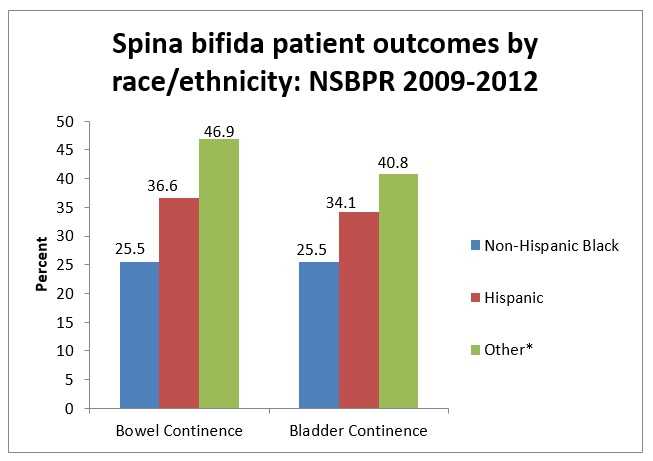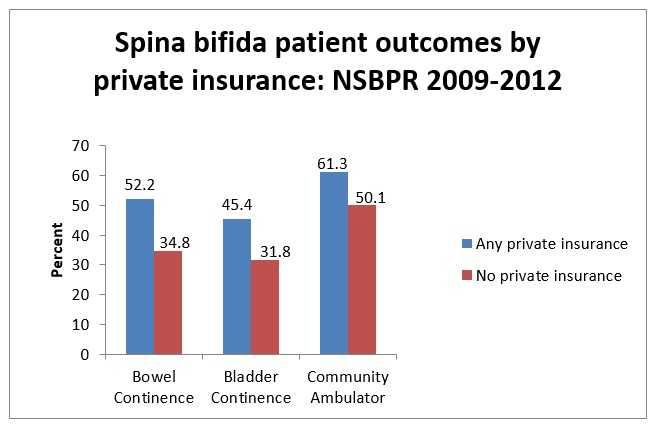Key Findings: Sociodemographic Attributes and Spina Bifida Outcomes
Data from CDC’s spina bifida registry suggests certain patients may have less favorable health outcomes

Newly released data from the National Spina Bifida Patient Registry (NSBPR) suggest that some patients with spina bifida have less favorable outcomes than others. This is the first large, multi-site clinic study to find relationships between patient characteristics (e.g., race/ethnicity, gender, health insurance coverage) and health outcomes. To date, there has been limited research on the long term health of people with spina bifida.
You can read a summary of the article here.
The NSBPR is funded and managed by the Centers for Disease Control and Prevention (CDC). These data were compiled from 2054 patients receiving care at ten spina bifida specialty clinics across the country between 2009 and 2012. These ten clinics participated in the NSBPR from 2009 to 2012.
Spina bifida is a birth defect that affects the spine and is usually apparent at birth. Spina bifida occurs when a portion of the backbone that protects the spinal cord, as well as the spinal cord underneath, do not form correctly during the pregnancy. This often results in damage to the spinal cord and nerves. Spina bifida can cause physical and learning disabilities that range from mild to severe.
Important findings from this study
This study found less favorable health outcomes among patients with spina bifida who were male, non-Hispanic blacks, or who did not have private health insurance.

Males had less favorable health outcomes for bowel continence and community ambulation.

*Other includes Asians, Native Americans, Hawaiians and non-Hispanic Whites. For the purposes of this study, these groups have been combined because their characteristics were similar.
Non-Hispanic blacks showed less favorable health outcomes for both bowel and bladder continence.

Patients without private insurance showed less favorable outcomes across three health measurements.
About this study
- This research reflects health outcomes among patients 22 years and under because most clinics in this study were pediatric clinics. The continence analyses were limited to patients five years or older, and the community ambulatory analyses were limited to patients two years or older.
- Patients were classified as having private health insurance if they reported health insurance coverage from a commercial plan. Patients were also classified as having private health insurance if they reported both private health insurance and public assistance or health insurance from a federally funded medical program, such as Medicaid.
What you can do
- Healthcare professionals: Healthcare professionals may want to consider additional care and services for their patients with spina bifida who could face less favorable health outcomes. Additionally, some patients may benefit from new strategies for improving bowel and bladder continence, ambulation (walking, with support if necessary), and the prevention of pressure sores (skin breakdown, typically on the back or buttocks from constantly sitting or lying down).
- Researchers: More research is needed to identify the reasons for differences in care and health outcomes of patients with spina bifida, which can also vary by spina bifida clinic. Certain patient characteristics should be considered when making these comparisons.
What CDC is doing
As of early 2015, there were 19 spina bifida specialty clinics providing data to the NSBPR, CDC supports 14 of these, and five are self-funded. The NSBPR includes data from more than 5,000 patients seen at spina bifida specialty clinics in the United States. Upcoming CDC research using data from the NSBPR includes:
- Studies identifying the differences in health outcomes by spina bifida clinic.
- A project to reduce the occurrence of skin breakdown using data from a subset of NSBPR clinics.
- Evaluating a series of tests and care to protect the kidneys of young children with spina bifida, using data from a subset of NSBPR clinics.
Resources
Overview of the National Spina Bifida Patient Registry
CDC’s spina bifida homepage
Spina Bifida Association
Reference for Key Findings
Schechter MS, Liu T, Soe M, Swanson M, Ward E, Thibadeau J. Sociodemographic Attributes and Spina Bifida Outcomes. Pediatrics. 2015 April; 135(4) e957-e964.
- Page last reviewed: April 8, 2015
- Page last updated: April 8, 2015
- Content source:


 ShareCompartir
ShareCompartir